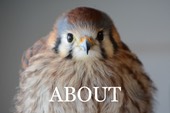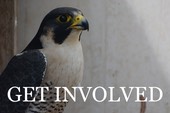Lots of Releases ~ 4 New Arrivals
Fall migration is well underway and it is bringing bats and nighthawks our way. A Silver-haired Bat and a Common Nighthawk were admitted on Monday. The bat was coated with canola oil, which in addition to being consumed by humans, is used to lubricate equipment. Bob and I bathed lots of dogs and cats during the 13 years we owned a pet grooming business. This was the first bat bath. After five scrubbings with Dawn Dish Soap, the rinse water was finally clean. The bat, an adult female, weighed 11 grams and loved giant mealworms! After hesitating for a few seconds she flew off into the darkness the next night.

The Nighthawk appears to have received a head injury. It has gotten a lot feistier as the week has progressed. Hopefully it and two other Nighthawks currently recovering from wing injuries will soon be releasable.
Swainson's Hawk Release
We said good bye to Emily this week, but not before she released an adult Swainson's Hawk at Wildhorse Resort Golf Course where the hawk had been found with a broken wing two months earlier. EJ Harris, East Oregonian photographer, captured the release. The hawk will soon be headed to Argentina for the winter. Emily will return to Walla Walla University. We wish both well!

More Releases
A Mule Deer fawn and a White-tailed fawn were both released this week as well as three Barn Swallows. It took the swallows a few minutes to find each other, but then they flew in large circles, demonstrating their very excellent bug-catching technique.
Prosser Heights Elementary School and a Thrush
On Friday the Education Team traveled to Prosser, WA to provide programs for 150 third graders (divided into 4 groups) and a Special Ed class. While at the school, a Swainson's (we think) Thrush was brought from Yakima. It has an injured elbow. The prognosis for release is guarded, but it is eating well which will give us time to see what antibiotics and immobilizing the wing can do.

American White Pelican
It seemed like a fairly quiet week until a call came in Sunday evening about an injured pelican in a goat pen north of Pendleton. That is essentially out in the middle of a wheat field, a long way from any body of water. To make matters worse, the goat in the goat pen did not like sharing her accom modations with the pelican. As we so often say, you just can't make this stuff up.

An examination revealed the pelican was quite thin and had lots of lice, both in the feathers and in its mouth. The photo below shows the inside of the pelican's very large mouth.

Because the pelican is such a large bird and requires a large quantity of fluids to rehydrate, an intravenous catheter was used to administer a large bolus of fluids. Pelicans have a large vein along the margin of their lower bill that is very convenient for placing a catheter.

Coming Events
The Education Team will travel to Sacajewa Park in Pasco, WA for Heritage Days on Friday and Saturday, September 26 and 27. Friday is open to school groups from around the region. Saturday the event is open to the public.







